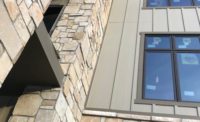The 80,000-square-foot Tilley Ladder Warehouse in Watervliet, N.Y. – once the oldest ladder manufacturing facility in the country – sat mostly vacant the past ten years. Built in the 1890s, the building contained bricks, wooden columns, high-beamed ceilings, an old sawdust room and a maintenance garage. In spite of its neglected condition, the structure, conveniently located in Watervliet’s Port Schuyler neighborhood and easily accessible to Interstate 787, presented an ideal site for energy efficient apartments. Furthermore, its proximity to a park and bike trail appealed to the aesthetics and eco-consciousness of the market-rate renter. Bringing this concept to reality required the collaborative efforts of several entities, including Sustainable Comfort Inc.
John Blackburn and Tom Rossi, developers at Redburn Development Companies LLC, specialize in the adaptive reuse and historic renovation of small apartment buildings with an emphasis on energy efficiency. They believed the site had potential and were determined to convert the building into 62 luxury loft-style apartments. Their efforts paid off when the project was ultimately considered one of the nation’s most energy-efficient residential developments with a LEED for Homes Platinum certification.
Typically, market-rate developers do not participate in green building programs and incentives. In many instances, the up front costs of building to green program requirements, such as LEED for Homes, are not perceived to outweigh the benefits of the marketing efforts and potential future savings. But Blackburn and Rossi, who had completed the award-winning River Street Lofts in Troy, New York, recognized the appeal to the current renter market. Their cutting-edge approach had been successful in the past, and Tilley Lofts would be no exception. With a month left in construction, the property was more than 90 percent leased.
In addition to pursuing LEED for Homes, the project hoped to earn New York State Energy Research and Development Authority (NYSERDA) energy efficiency incentives and Historic Building Tax Credits. To satisfy all requirements for each program, the developers had to engage in a careful balancing act. Old buildings typically were not designed with energy efficiency in mind and, while reusing them saves on new construction material, it is critical to maintain historic integrity while incorporating updated physical elements.
To preserve the building’s integrity, no major structural modifications could be made. Walls had to be thick enough to provide a tight building envelope, while all existing columns remained exposed. Overall wall depth could not be expanded more than four inches. The impact of high ceilings on the building’s heating and cooling loads had to be considered. The aging wooden structure made air sealing difficult. Historic preservation involves a commitment to remembering and honoring the past and preparing for a sustainable future.
“Working around the existing structural system and maintaining exposure of all columns in the building, while keeping the envelope in compliance with energy guidelines, was a big challenge on this project,” said Danny Sanders, Principal at Harris A. Sanders, Architects, P.C., the Tilley Lofts project architect firm. “We needed to make sure we ended up with no fewer than 62 units out of the building. Gross area is critical to the developer’s cost.”
Paul McCoy from Kirchhoff-Consigli Construction, the builder on the project, found air sealing the biggest challenge. “This building’s old wooden structure has many moving parts – creaking floors, walls and framing. Coordinating inspections of completed work for acceptance, as well as caulking and air sealing, was a large issue in an old facility of this nature,” he said. “We also ran into numerous penetrations through walls and plumbing penetrations through old wood floors. The energy requirements certainly added some time to the construction process.”
“Adding LEED to the project requires extra coordination time and the whole project team needs to step it up. Hiring Sustainable Comfort, Inc. during the preliminary design phase was important, and making the decision to engage them helped offset our costs,” Sanders reported. With Sustainable Comfort’s in-depth knowledge of the process, the project team was able to navigate the complicated maze of multiple program requirements and ultimately meet their goals and achieve incentives.
The end result? The building retained its historic character, while earning a LEED for Homes Platinum award; NYSERDA certified the structure as an Energy Smart building; and the project received various incentives and tax credits for energy efficiency and historic preservation. The Tilley Lofts was cited as one of the nation’s most energy-efficient residential developments in a Times Union article – while achieving a rental rate most market-rate developers would envy.
Energy efficiency features at the Tilley Lofts include ground source heat pumps; combined heat and power (CHP) that generates electricity and hot water; fresh air delivery to each apartment with heat recovery; high performance spray foam insulation; LED and smart lights; smart thermostats; and condensing washer/dryers. So far, the energy savings have been significant. Owner John Blackburn reported, “We’re actually generating electricity at the same efficiency percentages as a large natural gas powered generating facility.”
Residents enjoy a rooftop deck, fitness room, dog wash, on-site parking and, most important, all-in living. For a flat monthly fee, residents receive unlimited Internet, cable, electricity, heating and cooling, and hot and cold water. “With the all-in living, tenants pay about half what they would for the services separately,” said Blackburn. This win-win situation gives Redburn an additional revenue stream on the project, and enables the developer to capitalize on the energy efficiency measures by greatly reducing building operating costs.
This highly successful and fascinating project has become a case study for the multi-family development community. Many publications have featured articles about the Tilley Lofts, and Redburn has been asked to speak at several large industry events in New York State. In a market where it’s typical to spend as little as possible to preserve profit margin, the Tilley Lofts has shown that the opposite is true – hard work and investment can pay off. Performing this balancing act, although challenging, has put the Tilley Lofts in the spotlight as a national success story.



